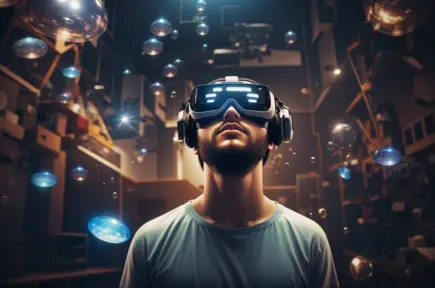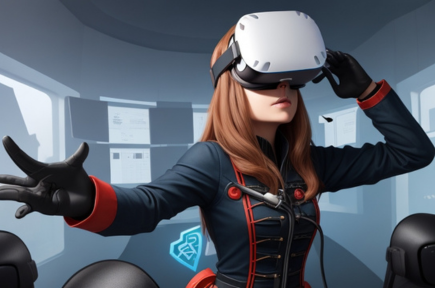Virtual reality (VR) has emerged as a groundbreaking technology that has revolutionized various industries and transformed the way we experience digital content.
In this article, we will delve into the definition of virtual reality, explore its working principles, and discuss its advantages and disadvantages.
Understanding Virtual Reality
Virtual reality can be defined as an artificial, computer-generated environment that simulates a realistic experience, allowing users to interact with and immerse themselves in a three-dimensional virtual world.
By wearing specialized headsets or using VR devices, users can enter and navigate these simulated environments, which are often designed to mimic real-world scenarios or entirely fantastical realms.
How Does Virtual Reality Work?
To comprehend how virtual reality works, it’s essential to understand the key components involved in the process. The primary elements of a virtual reality system include:
Headsets: VR headsets are devices worn on the head that display the virtual environment to the user. They typically consist of high-resolution screens, built-in motion sensors, and lenses to enhance the visual experience. Leading examples of VR headsets include Oculus Rift, HTC Vive, and PlayStation VR.
Tracking System: A tracking system is employed to monitor the user’s movements and translate them into the virtual world. This system ensures that users’ actions, such as head rotations or hand movements, are accurately reflected in the simulated environment. It enables a sense of presence and immersion, making the experience more realistic.

Input Devices: VR experiences often require input from users to interact with the virtual environment. These can range from handheld controllers and motion sensors to gloves or even full-body suits. Input devices facilitate actions such as grabbing objects, manipulating virtual elements, or navigating through the virtual space.
Powerful Computers: Virtual reality demands substantial computing power to render high-quality graphics and maintain a seamless experience. Advanced GPUs (Graphics Processing Units) are utilized to generate and display detailed visuals at a high frame rate, ensuring smooth and realistic virtual worlds.
By combining these components, virtual reality systems create an immersive experience that tricks the human senses into perceiving the simulated environment as real.
Virtual Reality: Advantages and Disadvantages
While virtual reality offers numerous benefits across various domains, it also has its limitations. Let’s explore both the advantages and disadvantages of virtual reality:
Advantages of Virtual Reality
Enhanced Training and Education: VR enables immersive training simulations that replicate real-life scenarios, providing a safe and controlled environment for learners. This technology is extensively used in fields such as aviation, medicine, and military training to enhance skills and reduce risks.
Improved Gaming and Entertainment: Virtual reality has revolutionized the gaming industry by offering unprecedented levels of immersion and interactivity. Gamers can now experience lifelike worlds, interact with virtual characters, and engage in thrilling gameplay like never before.
Also Read: The Metaverse and Blockchain
Virtual Travel and Exploration: VR allows individuals to virtually visit places they may not have the opportunity to experience physically. Whether it’s exploring ancient ruins, diving into the depths of the ocean, or even venturing into space, virtual reality opens up a world of possibilities for armchair travelers.
Therapeutic Applications: Virtual reality is increasingly being utilized for therapeutic purposes, such as treating phobias, post-traumatic stress disorder (PTSD), and anxiety. By exposing individuals to controlled virtual environments, VR therapy can provide a safe space for gradual exposure and rehabilitation.
Disadvantages of Virtual Reality
High Cost: VR technology can be expensive, requiring substantial investments in hardware, software, and computing resources. This cost factor may limit widespread adoption, especially for individuals or smaller organizations with budget constraints.
Health and Safety Concerns: Prolonged exposure to virtual reality can cause discomfort, motion sickness, eye strain, and other physical side effects. Additionally, the use of VR headsets may pose potential hazards, such as tripping or colliding with objects in the real world.
Limited Social Interaction: Immersion in virtual reality experiences can isolate users from the physical world and hinder face-to-face social interactions. This drawback raises concerns about its long-term impact on personal relationships and human connection.
Content Limitations: Although virtual reality content is continually expanding, the quantity and quality of available experiences may still be limited compared to traditional media. The development of compelling and diverse VR content remains a challenge for creators and developers.
Conclusion
In conclusion, virtual reality has made significant strides in transforming industries, education, entertainment, and therapeutic practices.
While it offers incredible immersive experiences and valuable applications, it also faces challenges related to cost, health effects, social isolation, and content availability.
As technology advances and VR becomes more accessible, these limitations may diminish, leading to a more widespread integration of virtual reality in our daily lives.


